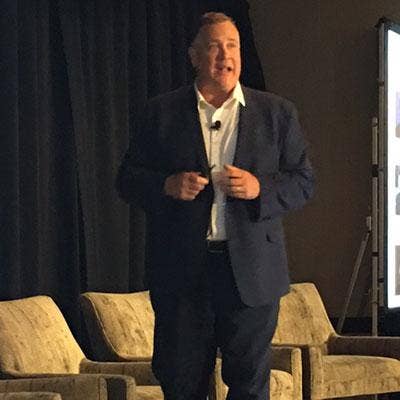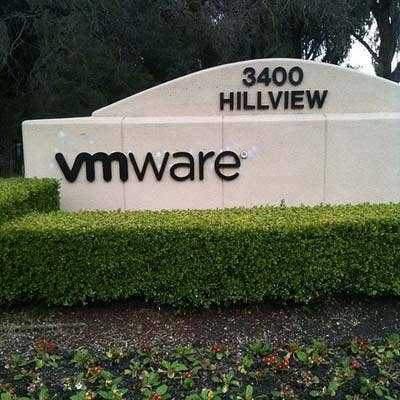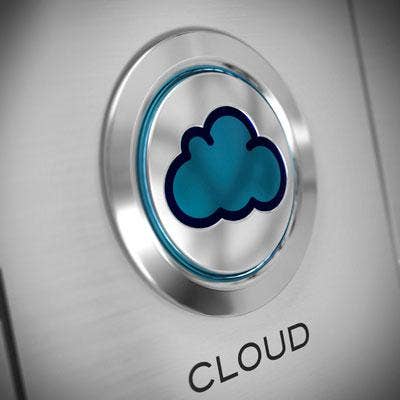GreenPages CEO Dupler On Being Technology-Agnostic; AWS And VMware; And Why Customers Want Out Of The Data Center Business

GreenPages CEO Ron Dupler On Digital Transformation Disruption
GreenPages Technology Solutions CEO Ron Dupler, the driving force behind the national strategic service provider's cloud-first services offensive, spoke with CRN about the company's digital transformation track record, its technology-agnostic strategy, the battle between AWS and Microsoft Azure, VMware Cloud on AWS, and why customers want out of the data center business.
Dupler spoke with CRN at the Kittery, Maine-based company's Cloudscape conference – an annual gathering aimed at helping customers drive competitive advantages with cloud technologies. This year's conference with 100-plus IT executive attendees featured a customer panel in which three top IT executives spoke about the real-world scenarios they faced crossing the DevOps public cloud chasm with the help of GreenPages.
Dupler said the disruption of all industries from the digital transformation phenomenon is accelerating, with a focus on application agility. "It is moving through industries of all types right now, including old-line industries like banking, insurance, retail and health care," he said. "The main point is we are leaping into a period where no industry is safe. People are coming in looking at how to leverage these technologies and disrupt industries."

What kind of digital transformation progress has GreenPages made in the last several years?
Our whole industry went through a phase where this whole cloud thing freaked everyone out and it became about cloud. It was never about cloud. It was never about technology. It was about using technology to drive competitive advantage for business.
I think the wave of technology industry talk around the importance of digital transformation has now got us all in this industry properly oriented. We all get the fact that what we do is a means to an end: to drive business results, drive revenue, increase productivity and profitability of organizations and, most importantly, help our clients serve their customers better.
Construed that way, 100 percent of what we do in some way, shape or form is oriented toward digital transformation. When you begin to look at how much of the work we are doing is around helping customers properly leverage cloud-based technologies to drive application agility and application velocity – which really fuels digital transformation -- about 50 percent of our work in our services organization ties into that.

How much application consulting and engineering prowess do you have now versus a year ago?
It continues to evolve. It is a significant transformation. This is our seventh annual Cloudscape. I would say we were early to market when we were talking about cloud computing and organizational transformation related to cloud computing.
This stuff is now mainstream. Our skill sets are changing with that. We have undergone a big organizational effort to get our teams ramped up and certified on both Azure and AWS. There is a lot going on right now around public cloud, but the fact remains that AWS right now is the market leader in that space.
If you are going to be in the hybrid cloud computing space advising customers, you certainly have to have something to say and have a good relationship with the folks at AWS. And we are a long-standing Microsoft partner and are doing a lot of work and having some great results around the Azure platform as well. Right now those are the two areas where we are skilling up our teams and doing active work today.

What do you see as the difference between Azure and AWS?
The difference between the two platforms is strategy. Microsoft is coming from the traditional IT enterprise side of the house and helping extend out to public cloud. Amazon is coming from the public cloud space and trying to figure out how to become friendlier to enterprise IT shops. Some enterprise IT shops have gone all in to Amazon, but a lot of enterprise IT shops are still trying to figure out today how to work effectively with AWS -- how to operate in that world and how to find partners that help them transact business in that world.

What role do you see for VMware on AWS?
VMware's strategy right now is to be the de facto cloud platform for a multicloud era. They view themselves as playing well with most of the major cloud providers.
AWS and VMware together with the initiatives they are putting in place strengthen both of their positions in the market.
Microsoft is extending Azure capabilities on-prem and then you have Amazon and VMware together with VMware Cloud on AWS. Those seem to be the two camps to really create a comprehensive platform to build and manage in a hybrid cloud world.

How fast is the public cloud train moving in the market?
It is going fast, but industry thought is maturing. Public cloud is growing ten-fold-plus. Traditional IT is still growing – depending on what we are talking about –in single digits and in some cases declining.
At the same time, some of the early [public cloud] adopters made some bad decisions. You are seeing publicity on some customers that have pulled workloads from the public cloud and brought them back on-prem. What that is symptomatic of is the industry continuing to mature in its perspectives and its thoughts around cloud.
This is use-case-driven. There are times when public cloud is a much better venue than what we would call on-prem or customer-owned technologies. There are other times when things are better run on-prem in the customer-owned architecture.
That is why we believe and our industry believes it is going to be a hybrid cloud world for some time to come.

Where do you see the public cloud versus hybrid cloud market settling out in terms of market share?
It's use-case-driven. A lot of it gets into modern application architectures. The underlying ecosystem is going to determine what the truth is long term. There are people with strong opinions on both sides. We cited last year at this event a Morgan Stanley survey that was aggressively predicting public cloud adoption being 50 percent of workloads running in the public cloud by 2020.
The jury is still out. We view these organizationally as tools. What is a must-have is customers have to be agile and they have to have high-velocity means to support application agility in their organization's business imperatives. The underlying technology that best enables that is the technology we are going to be enabling and working with.

How critical is the GreenPages 'agnostic' technology perspective in serving customers?
It is absolutely critical to our success. That has been our posture for many, many years. Some of our partners don't like that. But ultimately we understand we are here to serve our clients. In today's world, particularly with some of these cloud-based technologies, it is really the Wild, Wild West. Things are changing very rapidly. The fact is that we can come in with a vendor-agonostic stance and really provide advice that is pre-technology-based. We are looking at the things the technology needs to do to support the customer's business requirements and workflow and then ultimately the technology follows that. The consulting we are providing is use-case-driven, then workflow-driven. That drives and dictates the right technologies to get the job done.

How often do you think the wrong technologies are being brought to the table as a result of bad advice?
Oftentimes it is not necessarily the wrong technology -- it is a poor plan. They haven't really thought through their workflow so there are redundancies and it is a poor technology fit. It is not that it is a bad technology. It is just a poor fit for the use case. We see that a lot. Customers are confused today, and they are looking for clarity. Those organizations that can provide clarity are going to win.

What type of progress have you made with the annual Cloudscape conference?
For the last seven years, the Cloudscape conference has been a forum for us to collaborate with our customers and partners. It has been the forum where we have launched our new offerings and created the building blocks for what we are delivering in the market today.
The panel discussion this morning [where top IT executives complimented GreenPages for providing them much-needed help to cross the DevOps-public cloud chasm] provides great validation that we are able to offer world-class organizations and thought leaders within those organizations practical advice that helps them get their job done, delivers value and drives digital transformation.

How much pressure is there among customers to digitally transform and the channel?
There is a ton of pressure. There are very few, if any, industries that are immune from the pressures of digital transformation. Old-line industries are being transformed left and right: banking, insurance, health care. The leaders of these organizations get that.
Sometimes people take the negative side of this looking at the threat of disruption and there is a lot of pressure to respond. But by and large there is a huge opportunity, too. The reason there is so much pressure on legacy business is because they own legacy IT. If they were able to start their business today from scratch with the vision they have to digitally transform, their IT would look much different than it looks today.
The pressure is around taking that legacy IT and transforming it into an agile modern posture. That is the pressure. That is what we are helping customers do.

What is the difference between what you see today versus the first Cloudscape-themed Summit in 2011?
We were evangelizing early on in 2011 at the Cloudscape conference trying to stimulate and engage our customers, saying the world is changing under your feet right now and you need to start thinking about it. People were thinking about it and trying to figure it out, but there was lots of confusion and a ton of inertia.
This stuff is mainstream now. We see customers with transformation initiatives under way. Customers in general want out of the data center business. The executives I am speaking to are trying to figure out how to aggressively adopt public cloud to improve their IT posture.

What consolidation are you seeing in the channel as a result of the cloud business model change?
There are two things driving the consolidation. Number one it is a really hard transition that solution providers, VARs and systems integrators have to make right now moving from a revenue stream that was dominated by traditional IT -- selling big iron and helping customers integrate big iron -- and now moving into this next-gen model, which is really services based.
It is about recurring revenue and services. Skill sets need to change. Your internal processes need to change. Your sales compensation models need to change. It is not an easy transition. Anybody that says they are making it through this transition and doing swimmingly is full of it. You are seeing businesses hit the wall or preparing to hit the wall and they are bailing out. They are either being forced to bail out or choosing to bail out.

What are you are seeing from private equity in the current market?
You are seeing a number of companies in the industry -- both private equity and platform companies – who recognize there is tremendous, tremendous potential to take these old-line customer relationships that solution providers and VARs have and transform them into the modern IT era.
They also know that a lot of the people that have those [customer] relationships today don't have the financial or skills wherewithal to make that leap. They believe that by pulling these organizations in and having a team that can help customers round the turn they can create a next-generation super solution provider.

Where is GreenPages at with regard to the cloud era transformation?
We are very proud of what we have accomplished thus far as we sit here in August 2017. I have never had a better team of leaders in this organization. We think we are very well aligned with the market transition that is under way, and we are excited about the future. All that said, this isn't easy work right now. It is hard work and we are working hard.